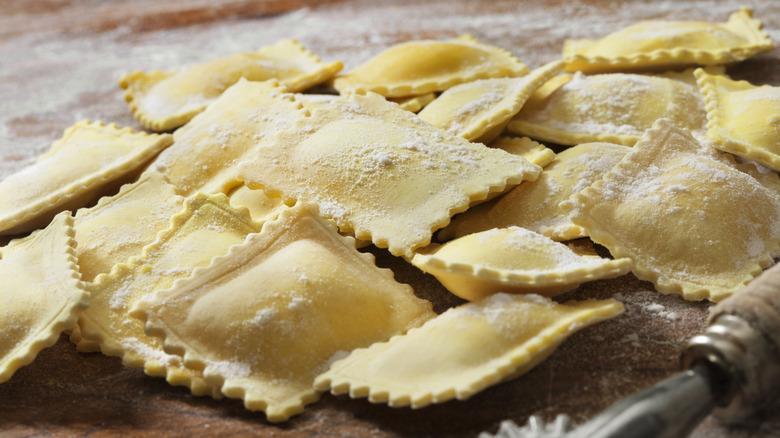Why You Shouldn't Make Homemade Ravioli With A Super Creamy Filling
If you've never made your own ravioli, now's the time to start. Unlike store-bought versions, a do-it-yourself pasta lets you experiment with all kinds of personalized flavors and fillings. If you love cheesy pasta, try your hand at an egg yolk and ricotta-filled ravioli. Or, channel the flavors of fall with a butternut squash version. You can get as creative or as simple as you want — so long as you don't go overboard with the cream.
When it comes to filling ravioli, there is, unfortunately, such a thing as too much of a good thing. Using an abundance of creamy filling may sound like a delicious choice, but it can actually overly-moisten your pasta dough. When your pasta dough gets too wet, it won't function the way you need it to. The dough can break or become difficult to seal, resulting in a messy, torn-apart ravioli square. This result often arises when you use a filling that's heavy on ricotta, butter, cream, oil, and the like.
This watery impact, however, doesn't mean you have to steer clear of creamy, gooey fillings entirely. Rather, there's one easy fix that will let you use all of the cheese — with none of the moisture.
Drain ravioli filing before adding to your dough
Ravioli dough is best rolled thin, so too much moisture can get in the way. You want a filling that's thick and on the drier side. If your creamy mixture looks too runny or grainy, it may ultimately ooze out of your ravioli dough. Nobody wants a filling that gets everywhere but inside the ravioli.
To achieve a firm, ideal texture — without sacrificing any flavor — try to minimize the moisture of your creamy ingredient. Specifically, you should drain your ricotta prior to using it. This step reduces the lingering liquid from the cheese, resulting in a firm, but still delicious, filling. Take note that the draining process typically pertains to store-bought ricotta; if you make ricotta from scratch, you'll have less moisture to begin with, and this process may no longer be necessary. You can also keep your creamy base as is, but give your filling time to sit and set in the fridge before using it. It requires a few hours to become firm and therefore lighten up on the liquid.
If you've never made your own ravioli, the process can seem intense, but it promises ravioli as the reward. Trial and error will help you settle on the perfect filling ... with the perfect amount of creaminess.

